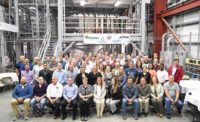A section of roof collapsed over a tunnel containing radiological materials on May 9 at the Dept. of Energy’s Hanford nuclear waste site in southeast Washington.
DOE declared a site area emergency for fear of potential radiation leaks, but there were no injuries and there is no evidence of a radiological release from the tunnel at the the PUREX facility, a former processing facility used to extract plutonium from uranium fuel rods, according to Destry Henderson, spokesman for contractor CH2M Plateau Remediation, The firm has a contract to decontaminate the facility.
A crew working to decontaminate the PUREX facility, discovered a 20 ft by 20 ft section of sunken soil over the tunnel, which was used from 1960 to 1965, says the Tri-Cities Herald. In 1964 a longer and more reinforced tunnel was added at PUREX.
“All personnel in the immediate area have been accounted for and are safe,” says Henderson. “There are no injuries and no evidence of a radiological release.” The six-employee crew was evacuated and all employees in the area were told to take cover, Henderson says.
Multiple contractors are working in the area. A Bechtel spokesperson confirmed to ENR that the firm, a contractor for the nearby high-level nuclear waste vitrification plant at Hanford, is not active at the PUREX facility.
CH2M did not immediately respond to a request for more information about the extent of its work at PUREX.
Hanford officials updated the public throughout the day as emergency crews responded to the tunnel site. Henderson says it is too early to know what caused the cave-in. The tunnel is used to store contaminated materials and is about 8 ft below the surface.
Responding crews used hand-surveying techniques to examine areas around the edges of the PUREX facility. Closer to the collapse, crews used a remote-operated device to monitor radiation and video the tunnel up to a half-mile away.
An initial emergency alert was expanded to a Site Area Emergency, used when an event could potentially affect personnel beyond the facility boundary but not beyond the boundary of the 580-sq-mile Hanford Site.
Shielding Radiation
The PUREX facility is more than 900 ft long and 64 ft above the ground, extending another 40 ft below ground. Concrete walls up to 6-ft thick were used in the plant to shield workers from radiation in the building. The plant was constructed in the early 1950s and operated from 1956 to 1972 and again from 1983 to 1988. Hanford officials say it may have produced more plutonium than any other building in the world.
Several rail cars used to transport the irradiated fuel rods from the Hanford nuclear reactors to the processing canyons remain buried inside a tunnel near PUREX. At the time of the tunnel collapse, officials were still evaluating options for decontaminating, removing and permanently burying the rail cars.




Post a comment to this article
Report Abusive Comment